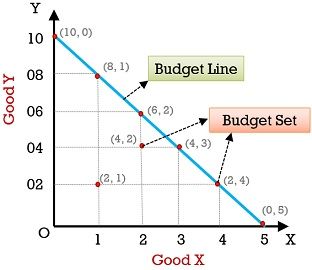 The consumer has a limited income, that acts as a constraint to his/her maximizing behaviour, i.e. the budget constrains how much the consumers can consume. While budget line graphically represents the bundle of two goods which a consumer can buy with the given budget. As against, all the combinations in the positive quadrant, which lie on or below the budget line are called a budget set.
The consumer has a limited income, that acts as a constraint to his/her maximizing behaviour, i.e. the budget constrains how much the consumers can consume. While budget line graphically represents the bundle of two goods which a consumer can buy with the given budget. As against, all the combinations in the positive quadrant, which lie on or below the budget line are called a budget set.
You might have come across the term ‘budget’ at least once in your life. To know what quantities of two commodities will be purchased by a consumer, what we need to know is – ‘How much money the consumer is willing to incur on those commodity and at what price the commodities are available in the market?’ This information will help us to plot a budget line.
What is Budget Constraint?
A budget constraint indicates that a consumer can pick any combinations of the two goods, provided that the cost is less than or equal to the income of the consumer.
In this post, we will talk about the differences between Budget Line and Budget Set.
Content: Budget Line Vs Budget Set
Comparison Chart
| Basis for Comparison | Budget Line | Budget Set |
|---|---|---|
| Meaning | The budget line is a graphical representation of all those combinations of two goods which can be bought with a given budget, at existing prices of the two goods, by fully spending the income. | Budget set entails all the combinations of the two commodities that a consumer can purchase with his limited income, at prevailing market prices. |
| Represents | Maximum limit which a consumer can spend on purchasing the goods. | All the sets of the two goods that fall on or below the budget line. |
| Equation | PXQX + PYQY = M | PXQX + PYQY ≤ M |
| Sets | The sets of two goods are equal to the income of the consumer. | The sets of the two goods are equal to or less than the income of the consumer. |
| Interrelationship | The budget line is the borderline of the budget set. | The different combinations of two goods that help in drawing the budget line, is the budget set. |
Definition of Budget Line
Budget Line refers to all the possible bundles of two goods, that a consumer can buy at a given income and price of the goods, when he spends his entire income, to purchase the two goods.
Alternatively, it is called a consumption possibility line or price line. The bundles indicate the maximum quantities of the commodity that can be purchased with the given income. It can be expressed as under:
PXQX + PYQY = M
Where,
PX = Price of good X
QX = Quantity of good X
PY = Price of good Y
QY = Quantity of good Y
M = Income
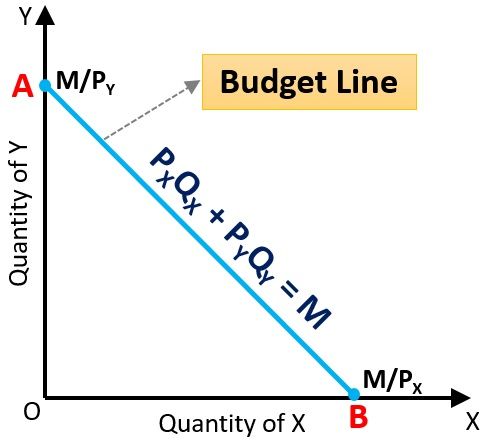
Therefore, all the consumption combinations which are within the consumer’s reach will fall on the budget line. Here the assumption is that the consumer spends all his money income on buying the two commodities.
- If X = 0, then Y = M/PY
- If Y = 0, then X = M/PX
OA = If the consumer incurs all his income on good Y, he can buy M/PY or OA units of Y.
OB = If the consumer incurs all his income on good X, he can buy M/PX or OB units of X.
AB = Budget Line
Assumptions of Budget Line
- Income of the Consumer is provided and remains constant.
- Price of the commodities are provided and remains constant.
When you have an idea of the prices and income of a consumer, you can easily draw a consumer’s budget line by determining the combination of the two commodities that a consumer can ‘just afford’ and create a straight line that passes through both the points.
Properties of Budget Line
- Downward Sloping: If a consumer wants more of a particular good, then he/she would have less of the other, indicating an inverse relationship. So the slope is negative due to which it is downward sloping.
- Straight-line: As the price of the commodity is irrespective of the quantity of units purchased, i.e. there will be no discount on volume. So, if a consumer wants one more unit of a commodity, he has to pay the extra amount for that, which is possible by foregoing a certain amount of the other good. Hence, the constant rate of sacrifice makes budget line a straight one.
- Full Utilization: Budget Line reflects that the consumer spends all his income, on the purchase of the two goods, which means that there is full utilization of the income.
Definition of Budget Set
Budget Set implies the set of all the possible combinations of two goods that the consumer can afford or buy, which his/her income, at the existing market prices. Basically, it contains all those combinations in the positive quadrant, fall under or on the budget line. It can be expressed as:
PXQX + PYQY ≤ M
Where,
PX = Price of good x
QX = Quantity of good x
PY = Price of good y
QY = Quantity of good y
M = Income
Further,
- If X = 0, then Y = M/PY
- If Y = 0, then X = M/PX
OA = If the consumer incurs all his income on good Y, he can buy M/PY or OA units of Y.
OB = If the consumer incurs all his income on good X, he can buy M/PX or OB units of X.
ΔAOB = Budget Set
For example Suppose a consumer has 100 rupees in his pocket, and there are two goods, pastries and chips, and both the goods are priced at ₹ 50. So, the combination of goods that the consumer can afford to buy are (0, 0), (0, 1), (0, 2), (1, 0), (2, 0), (1, 1)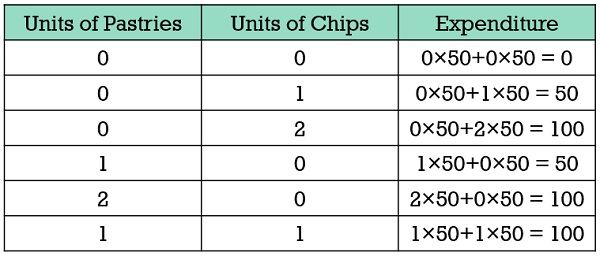
Here every bundle of bracketed value represents a budget set, which represents the set of two goods which consumer can buy, with his given income, at the prevailing prices in the market. Of the given combinations, (0, 2), (2, 0) and (1, 1) cost equal to ₹ 100, while the other costs less than ₹ 100. However, any combination other than those given above, for instance (2, 3), (3, 4), etc. will cost more than ₹. 100, at the given prices, which is simply unachievable.
What will happen if the prices of the goods and income of the consumer doubles?
If the prices of the goods and income of the consumer doubles then there will be no change in the Budget Set, because the double price will be offset by double income and the effect will be same.
Key Differences Between Budget Line and Budget Set
The difference between budget line and budget set can be drawn clearly on the following grounds:
- The budget line represents all those consumption possibilities of two commodities with the help of a graph, which the consumer can buy spending his entire fixed income on the two commodities, at their prevailing prices. On the other hand, a consumer can afford any combination of the two goods, that lies on or inside the price line, and so that area is termed as a budget set.
- The budget line indicates the maximum amount which a consumer can spend on purchasing the goods. As against, Budget Set represents all the combinations of the two goods that lie on or below the budget line.
- The price of the sets of the goods that form the budget line is equal to the income of the consumer. Conversely, in case of a budget set, the sets of the goods that fall on or under the budget line, indicates that the total price of the two goods is less than or equal to the income of the consumer.
- The budget line is the borderline of the budget set. This means that the points lying inside the budget line represent what consumer can afford, whereas points lying outside the budget line indicates what consumer cannot afford. In contrast, the different combinations of two goods that help in drawing the budget line are the budget set.
Shifts in Budget Line
We all know that, whatever purchases are made by the consumers, are based on two main factors – Consumer’s income and Prices of goods. So, these two factors decide the consumption limits of the consumer. Hence, if there is a change in any one of these determinants, it may result in the change of the budget line. Come let us understand the effect of change in these two factors:
Change in Income
- Increase in income
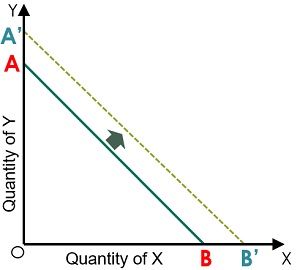
Suppose there is an increase in the income of the consumer, however, the prices remain unchanged. So, it is quite obvious that the consumer’s capacity to buy the goods will increase and so he will be able to buy more quantity of the same commodity. Consequently, the budget line shifts rightward. - Decrease in Income
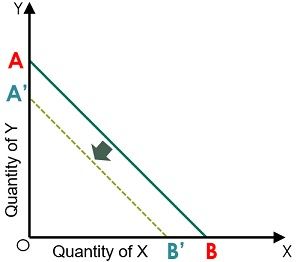
Suppose there is a decrease in the income of the consumer, and, the prices remains unchanged. So, this will decrease the consumer’s capacity to buy the two goods. Therefore, as per his new budget constraint, he will demand less quantity of the two commodities. This will shift the budget line leftward.
Change in Prices of Goods
- Change in the price of good X

Suppose the price of good X falls, but the price of good Y and the consumer’s income is the same. Resultantly, the consumer will be able to buy more units of good X. This will shift the line to the right. However, if there is a rise in the price of good X, the consumer will have to forego some units of good X. This will shift the slope on the left side. - Change in the price of good Y
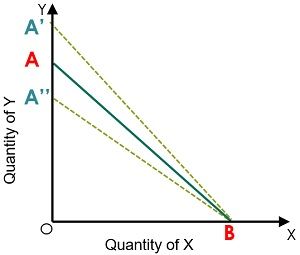
Suppose the price of good Y falls, but there is no change in the price of good X and the income of the consumer. As a result of which the consumer will be able to buy more units of commodity Y. This will shift the price line to the right. However, if there is an increase in the price of good Y, the consumer will have to forego some units of good Y. Hence, the slope will shift left. - Change in the Price of both the Commodities simultaneously
If there is a simultaneous change in the prices of the two commodities, by equal proportion and in the same direction, wherein the consumer’s income remains the same, then these two possibilities may take place: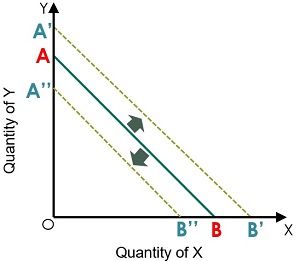
- If the price of good X and Y falls by an equal proportion, and in the same direction, then the price line will shift right. This will happen because the consumer will be able to buy more units of the two commodities with the same budget.
- If the price of good X and Y rises by an equal proportion, and in the same direction, then the price line will shift left. This is because, the consumer will have to forego some units of both the commodities, as the budget is fixed.
Example
The table represented below highlights the bundles of shoes (₹ 100) and clothes (₹ 200) a consumer can buy, spending his income, i.e. ₹ 1000.
Now let’s take a look at the graph representing Budget Line and Budget Set: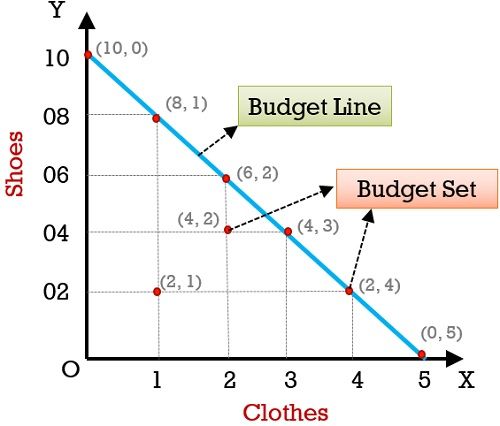
Conclusion
Basically, Budget Line shows the price ratio between two goods, i.e. X and Y or the rate at which one commodity can be exchanged for the other, where the prices of the two goods are given. Budget line depends on the consumer’s income and price of the commodities.
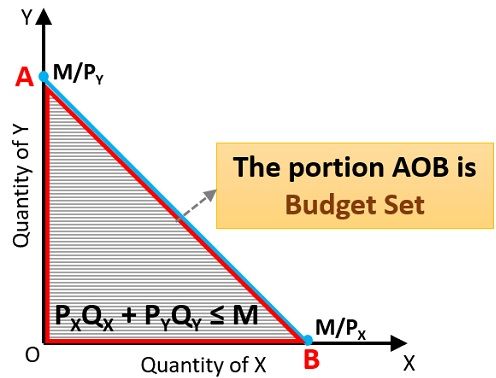







Leave a Reply